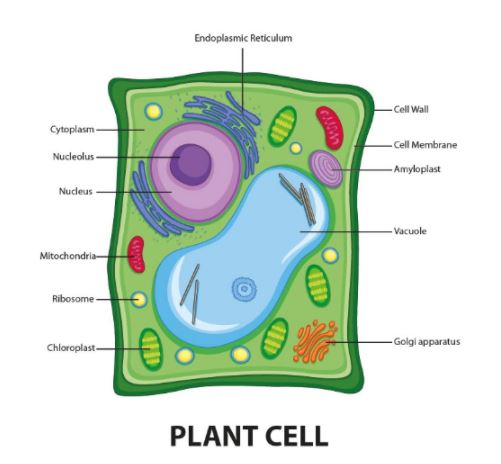
The cytoplasm is pushed to the periphery in a plant cell. Explain why?
Answer
456.3k+ views
1 likes
Hint: The cytoplasm was pushed due to the presence of membrane-bound cell organelles that are responsible for the maintenance of the osmotic balance of the cell. These cell organelles store water, organic and inorganic molecules along with the waste.
Complete answer:
Vacuoles are the organelle in the cells that help in maintaining the quantity of water and regulate the osmotic balance in the cell. The tonoplast is the layer that surrounds the vacuole and is structurally a single membrane-like structure that helps the vacuole to be separated from the cytoplasm. The main function of the vacuole is to maintain the osmotic or turgor pressure of the cell. They occupy most parts of the cell to maintain the shape and the osmotic balance of the cell. Thus the vacuoles are the cell organelles that are responsible for pushing the cytoplasm towards the periphery.
The tonoplast layer helps in the transportation of various substances that includes ions as well in the case of the plants to maintain higher cion concentration in vacuoles than the cytoplasm. They also store harmful substances like toxins to safeguard the cell.
Functions of vacuole:
- The shape of the cells are maintained by the vacuoles thus maintaining the cell’s turgor pressure.
- The color of the petals of the plants is due to certain pigments that are stored in the vacuoles.
- Vacuoles act as the storage organelle for water, and nutrients along with the waste products.
-The vacuoles help in the maintenance of the cell pH.
-The vacuoles help in performing various processes that include osmoregulation, degradative processes while in the case of the yeast the vacuoles help in storing amino acids.
-Vacuoles control buoyancy and constitute various gases thus named gas vacuoles.
-Vacuoles in the case of the animal cells help in the transportation, and constituent of the lipids and the proteins.

Note:
Vacuoles are present in all plant and fungal cells where it is larger in size while it is smaller in size in the case of the animal cells. The largest organelle of the cell is often said to be a vacuole. The vacuole that is surrounded by a membrane and is smaller in size will break and form a smaller vacuole called a vesicle.
Complete answer:
Vacuoles are the organelle in the cells that help in maintaining the quantity of water and regulate the osmotic balance in the cell. The tonoplast is the layer that surrounds the vacuole and is structurally a single membrane-like structure that helps the vacuole to be separated from the cytoplasm. The main function of the vacuole is to maintain the osmotic or turgor pressure of the cell. They occupy most parts of the cell to maintain the shape and the osmotic balance of the cell. Thus the vacuoles are the cell organelles that are responsible for pushing the cytoplasm towards the periphery.
The tonoplast layer helps in the transportation of various substances that includes ions as well in the case of the plants to maintain higher cion concentration in vacuoles than the cytoplasm. They also store harmful substances like toxins to safeguard the cell.
Functions of vacuole:
- The shape of the cells are maintained by the vacuoles thus maintaining the cell’s turgor pressure.
- The color of the petals of the plants is due to certain pigments that are stored in the vacuoles.
- Vacuoles act as the storage organelle for water, and nutrients along with the waste products.
-The vacuoles help in the maintenance of the cell pH.
-The vacuoles help in performing various processes that include osmoregulation, degradative processes while in the case of the yeast the vacuoles help in storing amino acids.
-Vacuoles control buoyancy and constitute various gases thus named gas vacuoles.
-Vacuoles in the case of the animal cells help in the transportation, and constituent of the lipids and the proteins.

Note:
Vacuoles are present in all plant and fungal cells where it is larger in size while it is smaller in size in the case of the animal cells. The largest organelle of the cell is often said to be a vacuole. The vacuole that is surrounded by a membrane and is smaller in size will break and form a smaller vacuole called a vesicle.
Latest Vedantu courses for you
Grade 11 Science PCM | CBSE | SCHOOL | English
CBSE (2025-26)
School Full course for CBSE students
₹41,848 per year
Recently Updated Pages
Master Class 11 Business Studies: Engaging Questions & Answers for Success

Master Class 11 Economics: Engaging Questions & Answers for Success

Master Class 11 Accountancy: Engaging Questions & Answers for Success

Master Class 11 Computer Science: Engaging Questions & Answers for Success

Master Class 11 English: Engaging Questions & Answers for Success

Master Class 11 Maths: Engaging Questions & Answers for Success

Trending doubts
Which one is a true fish A Jellyfish B Starfish C Dogfish class 11 biology CBSE

Difference Between Prokaryotic Cells and Eukaryotic Cells

1 ton equals to A 100 kg B 1000 kg C 10 kg D 10000 class 11 physics CBSE

1 Quintal is equal to a 110 kg b 10 kg c 100kg d 1000 class 11 physics CBSE

One Metric ton is equal to kg A 10000 B 1000 C 100 class 11 physics CBSE

How much is 23 kg in pounds class 11 chemistry CBSE




